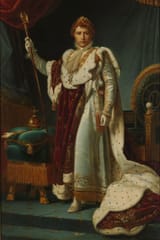Anonymous
7/21/2025, 2:28:17 PM No.17860215
Napoleon crowned himself Emperor of the French, replacing the Republoic born of 1789 with a dynastic monarchy under his family line.
He created an imperial nobility—princes, dukes, counts—whose titles and privileges were hereditary, reviving a tiered society the Revolution had abolished.
Napoleon married Marie-Louise of Austria, daughter of Emperor Francis I. This marriage tied Bonaparte’s regime directly to the Habsburg court and secured Austrian support against revolutionary republican movements elsewhere in Europe.
Through the Concordat of 1801, Napoleon re-legalized Catholicism as “the religion of the great majority of French citizens,” reversing the Revolution’s secularization and placating monarchs who viewed the Church as central to social order.
He granted the Church state funding and allowed bishops to be appointed by the Emperor, effectively making the Papacy an ally of his—and by extension of other crowned heads—in suppressing radical revolutionary currents.
Napoleon outlawed independent political clubs, shut down the free press, and required all local officials to be appointed by— and loyal to— central imperial authority, dismantling the popular assemblies that had driven 1789–1793 radicalism.
He exiled or imprisoned prominent Jacobins and other republican leaders, mirroring the Old Regime’s use of lettres de cachet to silence dissent.
The 1804 Napoleonic Code codified civil equality under the law but simultaneously secured property rights for landholders (many newly ennobled by Napoleon) and centralized judicial administration under imperial control.
Taken together, these measures show how Napoleon’s rise and rule systematically restored monarchical structures and alliances—effectively serving the interests of Europe’s traditional dynasties in containing and reversing the French Revolution.
Fell for it again...
He created an imperial nobility—princes, dukes, counts—whose titles and privileges were hereditary, reviving a tiered society the Revolution had abolished.
Napoleon married Marie-Louise of Austria, daughter of Emperor Francis I. This marriage tied Bonaparte’s regime directly to the Habsburg court and secured Austrian support against revolutionary republican movements elsewhere in Europe.
Through the Concordat of 1801, Napoleon re-legalized Catholicism as “the religion of the great majority of French citizens,” reversing the Revolution’s secularization and placating monarchs who viewed the Church as central to social order.
He granted the Church state funding and allowed bishops to be appointed by the Emperor, effectively making the Papacy an ally of his—and by extension of other crowned heads—in suppressing radical revolutionary currents.
Napoleon outlawed independent political clubs, shut down the free press, and required all local officials to be appointed by— and loyal to— central imperial authority, dismantling the popular assemblies that had driven 1789–1793 radicalism.
He exiled or imprisoned prominent Jacobins and other republican leaders, mirroring the Old Regime’s use of lettres de cachet to silence dissent.
The 1804 Napoleonic Code codified civil equality under the law but simultaneously secured property rights for landholders (many newly ennobled by Napoleon) and centralized judicial administration under imperial control.
Taken together, these measures show how Napoleon’s rise and rule systematically restored monarchical structures and alliances—effectively serving the interests of Europe’s traditional dynasties in containing and reversing the French Revolution.
Fell for it again...
Replies:
